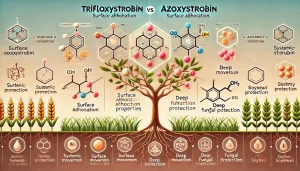Choosing between Trifloxystrobin and Azoxystrobin requires an understanding of their unique properties, modes of action, and applications in fungal disease management.
Both Trifloxystrobin And Azoxystrobin belong to the strobilurin class of fungicides, offering broad-spectrum protection, but they differ in systemic movement, persistence, and resistance management.
Trifloxystrobin excels in surface protection with strong adhesion, while Azoxystrobin provides deeper systemic control, making each suited for different agricultural needs.
In this guide, we’ll explore the key differences between these two fungicides, helping you determine the best option for effective disease prevention and crop protection
Related: What Is An Example Of A Translaminar Fungicide?
What Is The Difference Between Trifloxystrobin And Azoxystrobin? 10 best
1. Chemical Composition
Trifloxystrobin is a methyl-oxyimino-acetic acid derivative, while Azoxystrobin is a methoxyacrylate compound. These structural differences influence their stability and absorption in plants. Trifloxystrobin has a more lipophilic nature, allowing it to adhere well to plant surfaces, whereas Azoxystrobin is more water-soluble, enhancing its systemic movement.
These differences impact their effectiveness in different environmental conditions. Trifloxystrobin’s strong adhesion makes it more resistant to wash-off, while Azoxystrobin’s solubility enables better internal distribution. Understanding these properties helps in selecting the right fungicide based on crop needs and weather conditions.
2. Mode of Action
Both fungicides work by inhibiting mitochondrial respiration in fungi, but Trifloxystrobin has a stronger preventative effect. Azoxystrobin, on the other hand, exhibits curative properties, making it suitable for early and late-stage infections. The combination of these two in a spray program can provide enhanced disease control.
While Trifloxystrobin forms a protective barrier against fungal spores, Azoxystrobin moves within the plant to combat existing infections. Their differing modes of action make them complementary in integrated disease management programs, improving overall crop protection.
3. Crop Usage
Trifloxystrobin is extensively used in cereals, vegetables, and fruit trees, while Azoxystrobin is commonly applied to soybean, wheat, and rice. Their efficacy varies depending on the target crop, with Trifloxystrobin being preferred in high-value crops requiring prolonged protection.
Azoxystrobin’s systemic nature makes it ideal for crops that require internal disease control, while Trifloxystrobin’s residual effect is beneficial for crops with extended growing seasons. Choosing the right fungicide depends on the specific disease pressure and crop type.
4. Systemic Properties
Azoxystrobin is highly systemic, moving through the plant’s vascular system for internal protection. In contrast, Trifloxystrobin remains more localized, forming a protective layer on the plant surface. This makes Azoxystrobin ideal for deep-seated infections, while Trifloxystrobin excels at surface-level fungal prevention.
Due to its systemic properties, Azoxystrobin provides longer-lasting disease suppression, especially in fast-growing crops. Trifloxystrobin’s localized action, however, ensures a stronger immediate defense against spore germination and external infections.
5. Rainfastness
Trifloxystrobin has superior rainfastness due to its lipophilic nature, reducing the risk of wash-off after application. Azoxystrobin, being more water-soluble, may require additional formulation adjustments to enhance its rain resistance.
This means Trifloxystrobin is better suited for regions with frequent rainfall, while Azoxystrobin may need to be reapplied more frequently. Farmers must consider these factors when planning fungicide applications in varying weather conditions.
6. Resistance Management
Fungal resistance is a major concern with both fungicides. Trifloxystrobin, with its surface action, reduces selection pressure, while Azoxystrobin’s systemic movement makes it prone to resistance development. Rotating between these two fungicides can help mitigate resistance issues.
Using both fungicides in a well-planned rotation program reduces the chances of resistance buildup. Combining them with different fungicide classes further enhances disease control and prolongs their effectiveness in agricultural systems.
7. Cost and Availability
Azoxystrobin is generally more affordable and widely available due to extensive production. Trifloxystrobin, while effective, is often more expensive, limiting its use in large-scale farming operations where budget constraints are critical.
However, Trifloxystrobin’s longer residual activity may justify its higher cost in some cases. Farmers must weigh the price against the effectiveness to determine the best value for their specific crop protection needs.
8. Spectrum of Activity
Azoxystrobin has a broader spectrum of activity, controlling a wider range of fungal pathogens, while Trifloxystrobin is more specialized. This makes Azoxystrobin a more versatile choice for multiple crops and disease types.
Trifloxystrobin’s targeted action, however, provides superior control for specific fungal diseases. Selecting the appropriate fungicide depends on the prevalent pathogens in a given farming region.
9. Residual Activity
Trifloxystrobin has a longer residual effect on plant surfaces, offering extended protection. Azoxystrobin, though systemic, may degrade faster inside plant tissues, requiring more frequent applications.
For farmers seeking long-lasting surface protection, Trifloxystrobin is the preferred choice. Azoxystrobin, however, is better suited for combating internal infections that need immediate intervention.
10. Environmental Impact
Azoxystrobin, being more water-soluble, has a higher risk of leaching into water bodies, potentially affecting aquatic ecosystems. Trifloxystrobin, due to its lipophilic nature, binds more strongly to soil particles, reducing runoff risks.
Farmers should consider environmental safety when selecting fungicides, especially in regions with high rainfall or proximity to water sources. Implementing buffer zones and proper application techniques can mitigate environmental concerns.
Conclusion
Both Trifloxystrobin and Azoxystrobin serve as crucial tools in modern fungicide programs, each offering unique advantages.
While Trifloxystrobin provides better rainfastness and preventative control, Azoxystrobin ensures deep systemic protection and curative action.
Understanding Trifloxystrobin and Azoxystrobin differences allows farmers t o optimize their disease management strategies for maximum yield and efficiency.
o optimize their disease management strategies for maximum yield and efficiency.
For the best results, consider integrating both Trifloxystrobin and Azoxystrobin into a balanced fungicide rotation program. Choose the right fungicide today to safeguard your crops and improve productivity!
Recent Posts
8-24-24 fertilizers are widely used in agriculture to improve crop yield, root development, and nutrient balance. Their high phosphorus and potassium content makes them ideal for establishing strong...
A healthy lawn requires the right balance of nutrients to maintain color, density, and resilience. Choosing the correct fertilizer directly impacts grass growth and soil health. The 16-4-8...